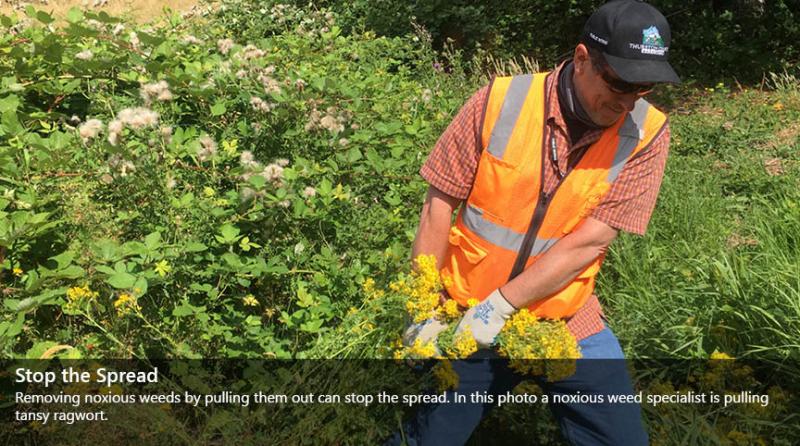Noxious Weeds

Background
Noxious weeds are non-native, invasive plants that threaten public health, the environment, wildlife habitat, native plants, agriculture and recreational areas. Once established in an area, noxious weeds become very difficult and costly to control.
A plant may be obnoxious or troublesome, but that does not make it a noxious weed. Noxious weed control laws RCW 17.10 and WAC 16-750 establish property owners’ responsibility to prevent the spread and control noxious weeds. Washington has been leading the nation in noxious weed prevention, passing its first law in 1881 to fight the spread of Canada thistle. More information on noxious weed laws can be found here.
Thurston County currently monitors for more than 40 noxious weeds that are known to be present or targeted for control in the county. Noxious weed species not yet present in the county are targeted through early detection surveys. A risk assessment chart is used to prioritize target weeds.
Species of Concern
In addition to the species listed on the county noxious weed list, five species pose a significant threat due to their ability to quickly and aggressively spread across an area. These species are not yet found in Thurston County.
- Spartina (Spartina spp.)
- Kudzu (Pueraria montana var. lobata)
- Hydrilla (Hydrilla verticillata)
- Water primrose (Ludwigia hexapetala)
- Flowering rush (Butomus umbellatus)
In addition to the species listed above, there are weeds of special concern because of their widespread presence. These include:
- Evergreen blackberry (Rubus laciniatus)
- Himalayan blackberry (Rubus armeniacus)
- Eurasian watermilfoil (Myriophyllum spicatum)
- Policeman's Helmet (Impatiens glandulifera)
- Canada thistle (Cirsium arvense)
- Scotch broom (Cytisus scoparius)
- Yellow nutsedge (Cyperus esculentus)
- English ivy (Hedera spp.)
Impacts of Noxious Weeds
- Reduce diversity in plant species
- Reduce wildlife forage and habitat by up to 90%
- Can be toxic
- Reduce quality of hay and forage
- Costs the United States USDA $185 billion per year in losses and control
- Reduce timber production in Oregon by $44.8 million per year
- Increase risk and intensity of wildfires
- Increase cost of roads and building maintenance
Integrated Pest Management
Integrated Pest Management (IPM) is an approach to pest and vegetation control that uses regular monitoring to determine if treatments are needed. It emphasizes physical, mechanical, cultural, and biological methods to keep noxious weed levels low enough to prevent damage, annoyance, or public safety hazards. If chemical control is necessary, choose the least toxic product available and always follow instructions on the label. Most effective treatment plans will integrate multiple control strategies.
Protecting Pollinators
Treat weeds prior to blooming to minimize negative impacts to bees and other pollinators. If treatment must occur during the blooming period, spray early or late in the day when pollinators are least active. It may be necessary to remove flowers from plants before spraying.
More information on bees and other pollinators:
- WSNWCB Bee
- WSU Honey Bees and Pollinators
- The Xerces Society for Invertebrate Conservation
- Olympia BeeKeeper Association
What You Can Do to Help
- Control noxious weeds on your land
- Report infestations when you find them
- Grow native and non-invasive plants in your garden
- Clean vehicles, boats, equipment and tools after each use
- Talk to your friends and neighbors about the impacts of noxious weeds and the importance of controlling them
